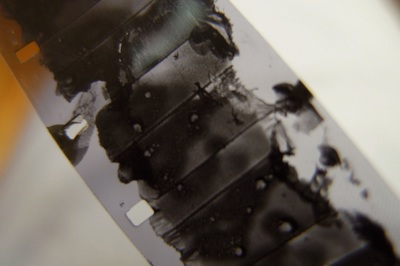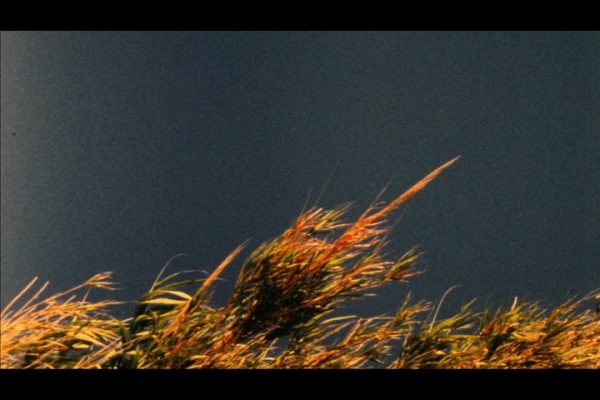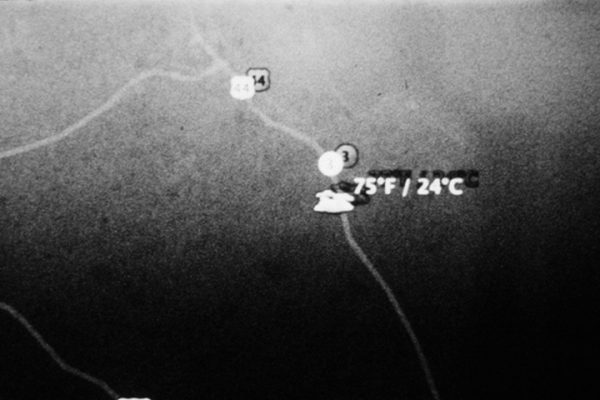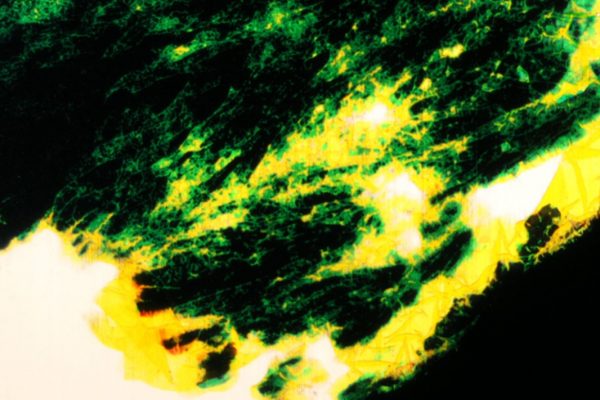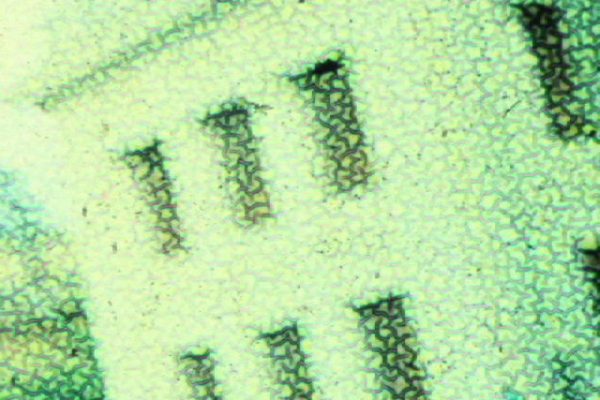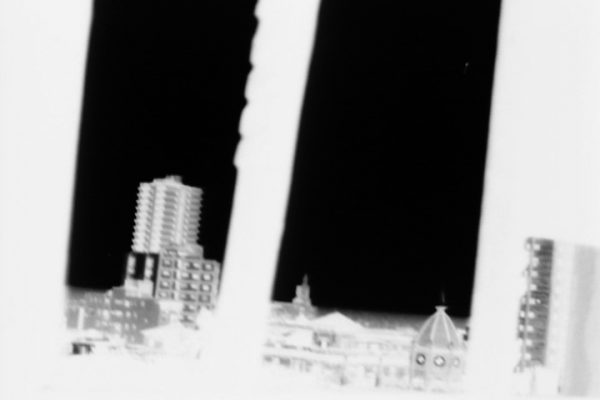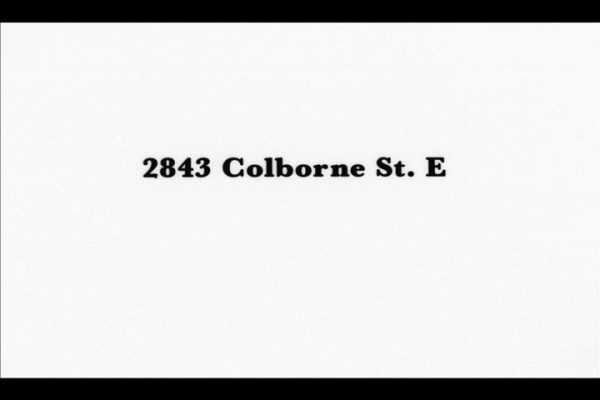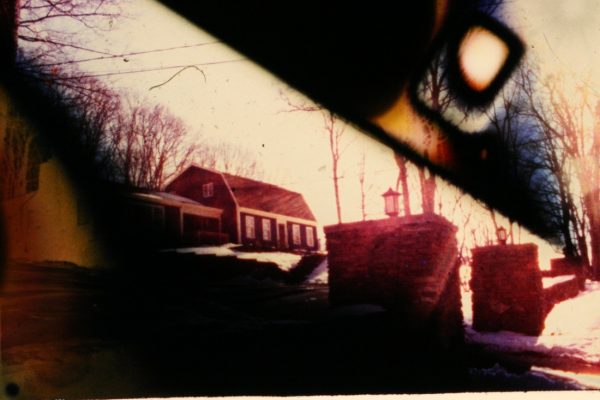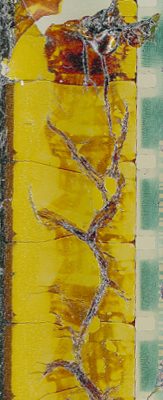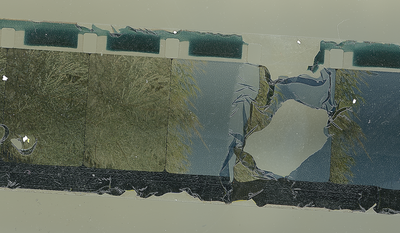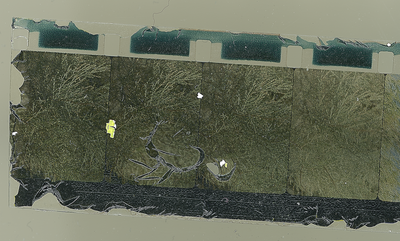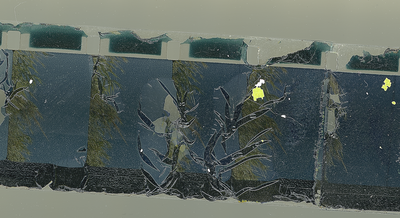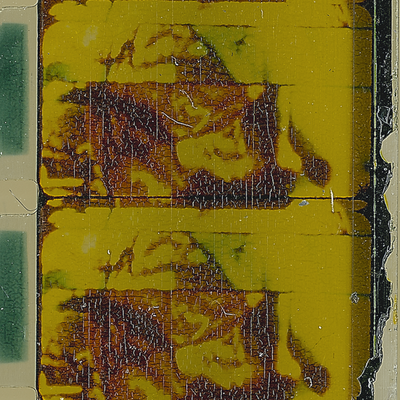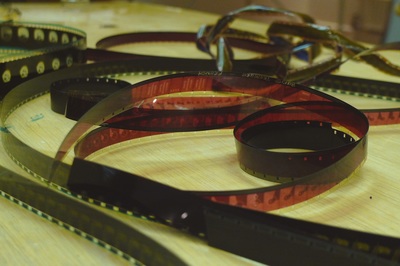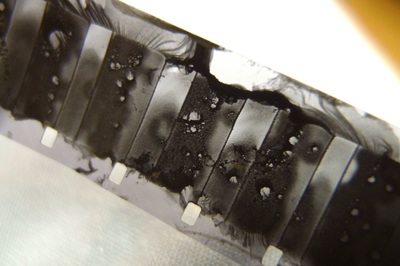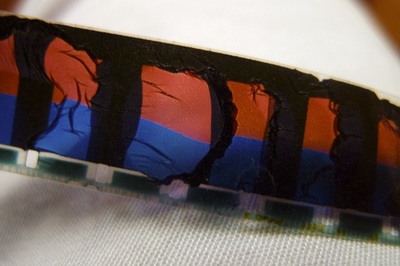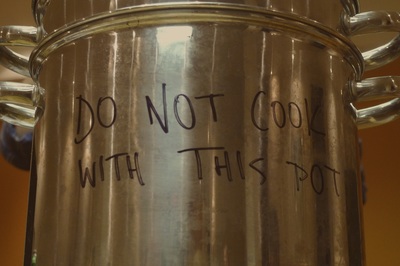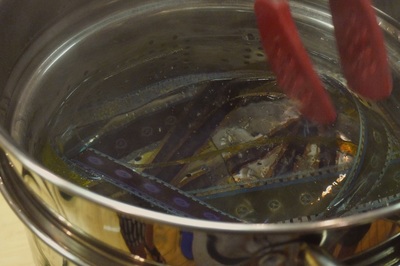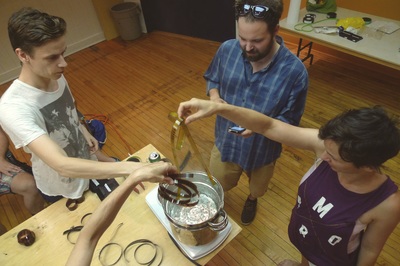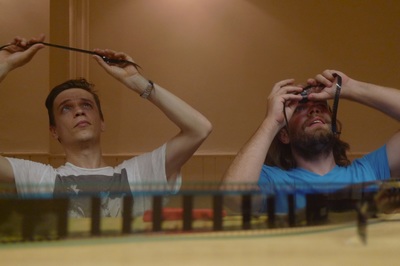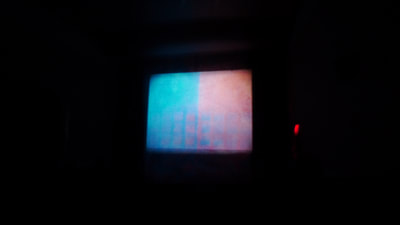Quand | When
20.08.2015 | 19h30
Où | Where
Cinéma excentris
3536, boul. St-Laurent, Montréal [QC]
Média | Media
16mm
En présence du cinéaste.
Billets | Tickets
cinemaexcentris.com
“With experimental film, I am attracted to the corporeal nature of the filmstrip and how this opens the emulsion up to the possibility of physical manipulations.” – Josh Weissbach
Employant des techniques cinématographiques expérimentales et de non-fictions, l’intégralité du projet filmique de Josh Weissbach examine des thèmes propre à l’espace d’émerveillement. À l’origine, Weissbach s’est concentré sur la relation entre l’intime et l’étrange dans l’espace domestique. Au cœur de ce processus se trouvait une enquête de l’agentivité visuelle de la forme construite et empreinte d’une histoire familiale traumatique.
JOSH WEISSBACH
Josh Weissbach est un cinéaste expérimental américain. Il vit dans une maison à proximité d’un village abandonné avec sa femme, sa fille et leurs trois chats. Maître en Beaux Arts, spécialisé en Film, Vidéo, Animation et Nouveaux Genres, gradué de l’Université du Wisconsin-Milwaukee, il a auparavant complété un baccalauréat en production film et vidéo, photographie et études cubaines au Collège Hampshire. Il est le fondateur et programmateur de The Grange, un microcinéma consacré à la présentation de films expérimentaux et de vidéos de non-fiction qui se trouve à East Haddam, CT. En 2008, il reçoit le Cary Grant Film Award de la Princess Grace Foundation-USA, en 2013, la bourse Mary L.Nohl pour les artistes émergents de la fondation The Greater Milwaukee Foundation, et en 2015, la bourse LEF du Robert Flaherty Film Seminar. Il a présenté ses films 16mm et ses vidéos numériques en festivals, dans des microcinémas et des galeries, et ce à travers le monde.
Démarche artistique
Employant des techniques cinématographiques expérimentales et de non-fictions, l’intégralité du projet filmique de Josh Weissbach examine des thèmes propre à l’espace d’émerveillement. À l’origine, Weissbach s’est concentré sur la relation entre l’intime et l’étrange dans l’espace domestique. Au cœur de ce processus se trouvait une enquête de l’agentivité visuelle de la forme construite et empreinte d’une histoire familiale traumatique. Dans son travail plus récent, tel que les installations de la série évolutive The Addresses, on retrouve une subversion de cette forme construite. Weissbach a aussi commencé à considérer les espaces naturels qui se définissent par la vitalité de la matière et sa force de transfert. Une grande partie du travail de Weissbach est empreinte par ses explorations des stratégies formelles qui changent la composition d’un cadre physiquement constitué par le grain da la pellicule.
Josh Weissbach is an American experimental filmmaker. He lives in a house next to an abandoned village with his wife, daughter, and three cats. He received his M.F.A. in Film, Video, Animation, and New Genres from the University of Wisconsin-Milwaukee, and his B.A. in Film-Video Production, Photography, and Cuban Studies from Hampshire College. He is the founder and programmer of The Grange, a microcinema specializing in experimental and non-fiction film and video based in East Haddam, CT. He is the recipient of the 2008 Cary Grant Film Award from the Princess Grace Foundation-USA, a 2013 Mary L. Nohl Fellowship for Emerging Artists from the Greater Milwaukee Foundation, and a 2015 LEF Fellowship from the Robert Flaherty Film Seminar. He has shown his 16mm films and digital videos in film festivals, microcinemas, and galleries worldwide.
Artist Statement
Employing experimental and nonfiction filmmaking techniques, the entirety of Josh Weissbach’s cinematic project examines themes of spatial wonderment. Originally, Weissbach focused on the relationship between the intimate and the uncanny within domestic space. Central to this process was an investigation of the visual agency of the built form and the manner in which it implicated a history of familial trauma. In more recent work, such as the latest installments of the ongoing series The Addresses, there has been a subversion of the built form. Weissbach has also begun to consider natural spaces that are defined by the vitality of matter and its transfer of force. In much of his work, Weissbach has explored formal strategies that alter the composition of a frame physically constituted by film grain.
MAPPING THE INTIMATE | CARTOGRAPHIER L’INTIME
[Oeuvres réalisées par | Works by Josh Weissbach]
20.08.2015 | Cinéma excentris | 19h30 | 58 min
« L’endroit où c’est arrivé, où cela a continué d’arriver, où c’est arrivé une seule fois. Les murs sont grands comme ça et il y en a tant, et il y a autant de portes et fenêtres pour sortir et entrer et regarder à travers. Voilà où le lieu se trouve sur la carte. Ici, les rues les plus proches et voici la façon de se rendre de là-bas à ici. Ici c’est là où ce qui est arrivé arriva, où ce qui est arrivé à continué d’arriver, où ce n’est pas encore arrivé. Parfois, il n’y pas de portes ni de fenêtres parce qu’il n’y a pas de murs. En décrivant le lieu, il devient fixe comme une image, comme une chaîne de mots.
Observant des espaces domestiques et naturels, Weissbach cherche des sites de trauma, de vitalité et de mémoire. Le spécifique devient général et le général devient spécifique. Des espaces psychologiques se réapproprient des termes architecturaux alors que des lieux commencent à modeler ce qui se trament en leur sein.
Les films de Weissbach sont impeccablement composés et rythmés. Leur amplitude permet de contenir et ressentir tensions et soulagements. Une grande partie de son travail est remplie d’une intensité impénétrable qui fait appel à ce même souffle pour exprimer données et drame, comme Jack Webb raconte simplement des sentiments.
Les fantômes trouvent des portes dans les murs, tandis que la télévision est collée sur une maison non-hantée. » -[ Notes de programme du Nightingale Cinema ,écrites par Jesse Malmed]
“The place where it happened, where it kept happening, where it only happened once. The walls are this tall and there are this many of them and there are this many doors and windows to exit and enter and stare out of. This is where it is on the map. These are the nearest streets and this is how you’d get from there to here. Here is where it happened next, where it kept happening, where it hasn’t happened yet. Sometimes there aren’t any doors or windows because there aren’t any walls. In describing the place, it becomes fixed as an image, as a string of words.
Examining both domestic and natural spaces, Weissbach seeks sites of trauma, vitality and memory. The specific becomes general and the general becomes specific. Psychological spaces take on architectural terms just as literal spaces begin to shape what happens inside of them.
Weissbach’s films are impeccably composed and paced, with an airiness that allows for both tension and relief. There is an inscrutable intensity to much of the work, using the same breath to express both data and drama, as Jack Webb says just the feelings.
The ghosts find doors in the walls, while the television is stuck on an unhaunted house.”- [Program Notes from Nightingale Cinema ,written by Jesse Malmed]
- STREET TWENTY-SEVEN NUMBER TEN SIXTEEN
- 200 N.W. 5TH STREET
- 106 RIVER ROAD
- MODEL FIFTY-ONE FIFTY-SIX
- 2843 COLBORNE ST.
- STORM CROSSING: SHIFTING GEOMETRIES
- INVERTED EXTERIORS
- THEORIA
2015 | 16mm | 2 min 47 sec
Dans Street Twenty-Seven Number Ten Sixteen, le souvenir d’une chambre d’un appartement situé au troisième étage d’un bâtiment. Une rêverie issue d’une chanson d’amour mélancolique qui joue dans un avion, volant vers une île, nageant entre deux eaux, celles d’un océan et d’une mer. La douce brume d’un embargo se dissipant lentement dans le bleu céleste.
In Street Twenty-Seven Number Ten Sixteen there is the memory of a bedroom in an apartment on the third floor of a building. There is a reverie of a melancholic love song playing on an airplane, flying towards an island, straddling an ocean and a sea. There is the soft haze of an embargo slowly lifting into the celestial blue.
2014 | Digital video on 16mm | 3 min 46 sec
Se réappropriant une image de la démolition du cratère architectural qu’était le bâtiment Alfred P.Murrah Federal Building, site de l’attentat à Oklahoma City, 200 N.W. 5th Street présente le contrecoup du terrorisme intérieur, alors que silhouette et forme capitulent face à la topographie d’une fumée onduleuse.
Using an appropriated image from the demolition of the architectural crater that was the Alfred P. Murrah Federal Building, the site of the Oklahoma City Bombing, 200 N.W. 5th Street presents the aftermath of domestic terrorism, as shape and form surrender to a topography of undulating smoke.
2011 | 16mm | 5 min 53 sec
Alors qu’une accumulation d’artefacts développés à la main déplace une image singulière vers l’abstraction, un document de cour rédigé en jargon juridique est lu mot pour mot, révélant partiellement les détails mystérieux d’un événement domestique.
As an accumulation of hand-processing artifacts moves a singular image towards abstraction, the legalese of a court document is read verbatim, partially revealing the arcane details of a domestic event.
2014 | 16mm | 11 min 02 sec
Model Fifty-One Fifty-Six expose les changements physiques du cœur du créateur vivant depuis sa naissance avec le trouble congénital de discordance ventrico-artérielle. Cette chronique présente le devenir cyborg d’un humain, reliant la vulnérabilité personnelle à la science fiction des années 1980.
Model Fifty-One Fifty-Six displays the physical changes of the maker’s heart since being born with the congenital disorder, Transposition of the Great Vessels. This chronicle showcases a movement from human to cyborg that connects personal vulnerability to 1980s science fiction.
2012 | 16mm | 10 min 56 sec
Noir / Blanc / Image / Son / Père / Fils / 2843 Coborne St.E
Black / White / Image / Sound / Father / Son / 2843 Colborne St. E
2012 | 16mm | 14 min 31 sec
storm crossings : shifting geometries présente le point d’intersection de deux tempêtes qui simultanément s’accroissent et décroissent.
storm crossings : shifting geometries presents a generated intersection between two simultaneously decreasing and increasing storm systems.
2013 | 16mm | 2 min 43 sec
Inverted exteriors porte sur les conditions d’une extrémité, qu’elle soit de nature architecturale ou topographique.
Inverted exteriors considers the conditions of an edge, whether that edge be architectural or topographic.
2014 | 16mm | 5 min 46 sec
Un Grec, jadis guide sur l’île de Delos, a commencé à discourir sur la signification du mot « théorie ». Notre conversation qui s’en est suivie constitue l’inspiration initiale à la base de ce film intitulé theoria [theh-oh-ree-ah].
A Greek man, once a guide on the island of Delos, started discussing what the word theory meant. Our ensuing conversation was the initial inspiration for this film, entitled theoria [theh-oh-ree-ah].
COOKING WITH 16MM
VISIONS is proud to host a workshop with August’s visionary, Josh Weissbach.
In this film-boiling workshop from Josh Weissbach, participants will have the opportunity to experiment with one of the primary formal strategies utilized by the filmmaker himself. Weissbach will discuss and present the process of boiling film, the effect of reticulation, and how it connects to the conceptual leanings of his cinematic practice. In addition, Weissbach will talk about the other strategies he employs to formally treat the film frame and how they visually inform his project of mapping the intimate. Each participant will have the opportunity to boil his or her own film and create frame by frame manipulations within the film’s emulsion while hanging out with Weissbach in a laid-back environment. While doing this, the group as a whole will develop a growing list of how different film stocks respond to being shocked by heat within a pot of boiling water.
The date and time of the workshop will be confirmed depending on participant availability.
There are only 8 places available. The cost of the workshop is $15 per person.
All participants will have a free ticket for the Weissbach screening on the 20th at Cinema Excentris.
Reserve your place now. First come first served.
Contact us for more information or to reserve your place.
Read “THE VALUE OF DISORIENTATION”
a reflection on the works of Josh Weissbach by Minou Norouzi
would like to think about disorientation as something capable of producing its own rewards. Disorientation conjures navigational initiative: Where am I? What am I doing? What is this? If being lost can be considered an honest state, then creative or political agency resides in locating one’s body in space, one’s feelings in time.In examining the collision of film objects and viewing bodies, the power of images and our agency as onlookers are most usefully entwined in a process of mutual consideration. Hans Belting proposes that “the act of looking is not only attracted by images but is also displayed in them, as if images had a faculty of looking themselves or could reciprocate our looks.”1 Here the philosophical potential of a reciprocated relation lies in the idea of togetherness, of relational experiencing. But the image cannot experience its audience. Images are stoic yet vulnerable, standing alone. Then what if the image is absent?
Josh Weissbach’s 2843 Colborne St. E, one of three films in the series The Addresses, is made of a transparent piece of leader which, through a contact film printing process, produces a black image. Though in reality the audio features two cross-generational conversations between two pairs of fathers and sons, I prefer a Jungian reading: Corey is bathing his son, floating between the tenderness of his interactions with the boy and tense, instructive exchanges with his own father, who appears to be in financial trouble as he anticipates a meeting with the social services. Corey’s reassurances are met with verbal abuse. The kind that grows out of nervous tension. The kind we can only afford in love. It’s familial.
Since there is no image, it is through listening that we begin to produce our own projections. Here are mine: The bathroom sits at the end of a narrow corridor, leading to a large living room. The kitchen is annexed there through a smallish hatch. The house hasn’t been refurbished since the ‘80s. Corey is moving between two spaces, two conversations, two generations. Between tenderness and abuse.
It may take multiple viewings to note that there are no footsteps. The two conversations are not in fact happening at the same time, or in the same space. The sonic fabric gives way to a dissonance between reality and the imagined.
“The projected blackness that is not darkness,” as Weissbach puts it, is partially a representation of his relationship to the material. He was not present during either of the recordings. In the absence of image, the meaning of surreptitiously recorded conversations needs to be eluci-dated, producing disorientation: “Do I close my eyes? Do I think of the space, the people I am sitting with? I am interested in the contract between the viewer and the screen. I want people to be next to each other when they are encountering the nastiness that’s going on. Until that final moment when the title snaps you back into the space of cinema.”
As is the case with all of the works in the Addresses series, it is disorientation that sparks our navigational initiative towards each other and our surroundings. And therein lies the power not of images alone but of the potential for relational experiencing that Josh Weissbach solicits so eloquently with these films.
1. Hans Belting, “Body and Image,” in Iconic Power, edited by Jeffrey C. Alexander, Dominik Bartmanski and Bernhard Giesen (New York: Palgrave Macmillan, 2011), p. 187.
Minou Norouzi is a filmmaker, film programmer, and Ph.D. by practice researcher at Goldsmiths, University of London.
Translation to French © Emma Roufs



